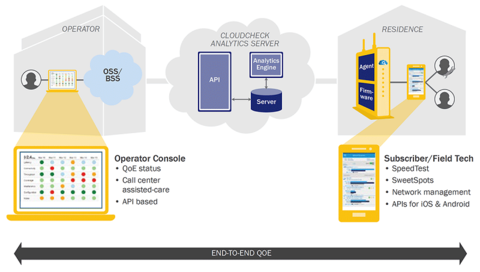ASSIA, a software management vendor for broadband providers, added three more large service provider customers, putting its Expresse broadband management and CloudCheck Wi-Fi management products inside 25 million additional subscriber homes.
While ASSIA did not reveal the names of the customers, this latest roster includes Tier 1 North American cable MSOs and two of the world’s largest service providers with operations in Europe and Latin America.
RELATED: BT, Assia reach settlement on DSL technology patent dispute
ASSIA has already deployed its Wi-Fi management solution at multiple service providers such as AT&T, CenturyLink, Verizon and Telus, all of which are improving customer experience while driving down customer support costs.

A cloud-based solution, CloudCheck Wi-Fi manages and optimizes customer in-home Wi-Fi environments to enable improved performance and facilitate self-healing, self-help and self-install capabilities for the residential broadband user. Replying to demand from multiple service providers, ASSIA’s CloudCheck is now supported on over 100 different gateway models from the leading vendors.
David Raun, president and COO of ASSIA, told FierceTelecom that while service providers initially balked at taking responsibility for overseeing in-home Wi-Fi issues, the company is seeing more of them use their software to provide a better customer experience.

“Initially, service providers said it was not their problem, but when they kept getting the phone calls they realized it was their problem,” Raun said. “What’s happening is that we’re winning some very highly visible designs and people are starting to notice it.”
ASSIA’s thesis about managing in-home Wi-Fi is a topic that’s gaining industry-wide momentum, particularly through the emergence of new standards like the IEEE’s 802.11ac.
The standard has multistation throughput of at least 1 Gbps and single-link throughput of at least 500 Mbps as well as greater range inside of a home.
At the same time, third-party testing labs like the University of New Hampshire InterOperability Laboratory (UNH-IOL) recently introduced a new set of Wi-Fi testing capabilities, reflecting a movement to help service providers and gateway vendors enhance broadband customers’ Wi-Fi broadband experience, for example.
Customer-driven CPE partnerships
Being an insurgent broadband management software, ASSIA is finding partnerships are key to winning large customers by synching up with the large customer premises equipment (CPE) vendors.
The company is finding that some of its CPE competitors market that also have their own software-based management solutions are being asked to partner with the company during a new service roll out.
“One of the dynamics that’s happening is some of the people we’re competing with are hardware suppliers that have their own solution and then you get a big customer saying: we made the decision to use CloudCheck and you need to put it on your box,” Raun said. “What you’ll see over time is more partnerships form with us.”
Today, ASSIA’s CloudCheck platform supports over 100 unique CPE platforms across all the major Wi-Fi chipset providers.
Some of the CPE vendors it supports include household names such as ARRIS, ADTRAN, Askey, ASUS, Arcadyan, AirTies, HITRON, Huawei, Linksys, Mitrastar, Netgear, TP-Link, Sagemcom, Technicolor and Zyxel.
“We tried going to the large CPE vendors on our own and were told they had their own solution,” Raun said. “When the customer makes the decision and asks us to work together and that’s why we have been able to get those 100 models because our mutual customers have asked for that.”
However, HITRON saw using ASSIA’s software as a potential way to differentiate its CPE from its competitors.
“HITRON is a second-tier CPE vendor and decided they would run with the Wi-Fi management tools as an advantage and it’s worked well for them,” Raun said. “They are starting to beat some of the big guys and they say part of it is because of the software.”
Another advantage of the CPE partnerships is that it also enables service provider’s technicians and call center employees with common tools. This is because they won’t have to manage multiple management platforms to resolve customer issues.
“We’re sending the message that company A make like using 4 vendors and this software can go across all four rather than using four different solutions, and that’s compelling for multiple reasons,” Raun said. “One reason is the software interface of the customer care centers and technicians don’t want to have multiple solutions and that gives more power to suppliers to price games rather than being locked in because of the software element.”
Charting new growth directions
This milestone also comes at a multiyear transitional time for the software management vendor.
David Raun took over the day-to-day operations of the company as president and COO in April of 2016 while CEO and founder John Cioffi remained focused on the company’s long-term vision, advanced technology and IP. The two appear to work well together.
Since Raun took over the helm, ASSIA has continued to see financial and customer growth.
In 2017, the company grew 56% with the expectation to see further growth in 2018.
“We’re growing the Expresse business, which is the modules for GPON and DSL, but it’s at a slower rate,” Raun said. “What’s starting to kick in is the cloud part of the business, which is our Wi-Fi management tools.”
This article was updated on March 27 to more accurately reflect ASSIA's top leadership.
